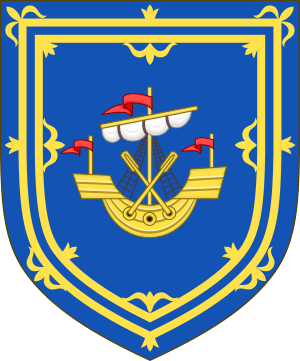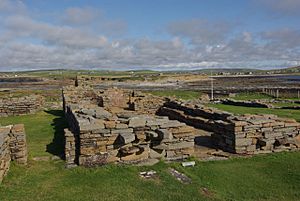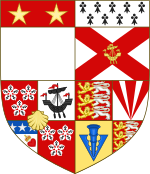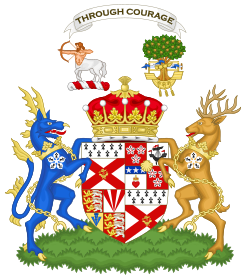Earl of Orkney facts for kids
Quick facts for kids Earldom of Orkney |
|
|---|---|

Arms of the Earl of Orkney
|
|
| Creation date | c. 872 |
| Monarch | King Harald I |
| First holder | Sigurd Eysteinsson |
| Present holder | Peter St. John |
| Heir apparent | Oliver St. John |
| Extinction date | 1472 (first creation) 1614 (second creation) |
| Seat(s) | Earl's Palace, Kirkwall |
| Former seat(s) | Brough of Birsay Earl's Palace, Birsay |

The Earl of Orkney, also known as the Jarl of Orkney in old times, is a special noble title. It covers the islands of Orkney and Shetland, which are part of the Northern Isles of Scotland.
These rulers were first set up by Norse (Viking) people. In 1195, their role as Norwegian vassals (meaning they served the Norwegian king) became official. The old Norse word jarl is similar to "earl." However, a Norwegian jarl was not exactly the same as an earl in other places.
In the early days, the jarls had a lot of freedom. By the late 11th century, the Jarl of Orkney became the most important person in medieval Norway, after the king himself.
The jarls also sometimes answered to the kings of Scotland for parts of their land in mainland Scotland, like Caithness and Sutherland. In 1232, a Scottish family took over from the original Norse family. But the islands still officially belonged to Norway. Later, other Scottish families, like the Sinclair family, held the title. During their time, Orkney and Shetland became part of Scotland.
A second earldom was created in 1581 by James VI of Scotland. This was for his half-uncle Robert Stewart. But after only two people held the title, it was taken away in 1614. A third earldom was created in 1696, and this title still exists today. However, these later earls had very little to do with Orkney itself.
Contents
Norse Jarls: The First Rulers
| Jarldom of Orkney (Norse) | |
|---|---|
| Creation date | c. 892 |
| Monarch | Haraldr Hárfagri? |
| Peerage | Peerage of Norway |
| First holder | Sigurd Eysteinsson |
| Last holder | Jon Haraldsson |
| Subsidiary titles | Mormaer of Caithness |
| Status | Extinct |
| Extinction date | 1230 |
| Former seat(s) | Brough of Birsay |
Rognvald Eysteinsson, the Jarl of Møre, who lived around 865–890, is sometimes seen as the first founder of the jarldom. The Orkneyinga saga (a historical story) says that King Harald Finehair gave him control over Orkney and Shetland. But it doesn't clearly say he held the title himself. Another old text, the Heimskringla, says Rognvald's brother Sigurd was the first to officially be called a jarl.
Sigurd's son, Guthorm, ruled for only a year and had no children. Then Rognvald's son, Hallad, took over. But he couldn't stop Danish raids on Orkney. So, he gave up the title and went back to Norway, which people found quite funny.
Torf-Einarr then managed to defeat the Danes. He started a family line that ruled the islands for many centuries. Some historians believe that Torf-Einarr was the first true Earl of Orkney.
Another idea is that Sigurd “the Stout” Hlodvirsson, who was Torf-Einarr's great-grandson, might have been the first Jarl. This is because some old writings suggest Orkney wasn't fully taken over until the time of Harald Hardrada (who ruled Norway from 1043 to 1066). We don't have exact dates for many of these early jarls, except for Sigurd the Stout, who died in 1014.
If Torf-Einarr was a real historical figure, then almost all the jarls who came after him were his descendants. The only exception was Sigurd Magnusson. His father, Magnus Barelegs, made him jarl for a short time. Sigurd later became King Sigurd I of Norway.
One of the main sources of information about these jarls is the Orkneyinga saga. This saga is a very important historical and literary record for Scotland. A key event in the saga is the death of Jarl Magnus Erlendsson, who later became known as Saint Magnus, around 1115. The last part of the saga tells the long story of Jarl Rögnvald Kali Kolsson and Sweyn Asleifsson.
After Jarl Jon Haraldsson passed away about sixty years later, Magnus, son of Gille Brigte became the first of the Scottish earls. He might have been related to Jarl Rögnvald Kali Kolsson, but this isn't fully proven. The line of Norse jarls is said to have ended when Jarl Magnus II was given his title by Haakon IV of Norway around 1236.
| Name | Known as | Relationship to previous jarl | Start of rule | End of rule |
|---|---|---|---|---|
| Sigurd Eysteinsson | Sigurðr inn riki "the Mighty" |
Brother of Rognvald Eysteinsson | c. 892 | |
| Guthorm Sigurdsson | Son of Sigurd Eysteinsson | c. 892 | c. 893 | |
| Hallad Rognvaldsson | Son of Rognvald Eysteinsson | c. 893 | c. 895 | |
| Einarr Rognvaldsson | Torf-Einarr "Turf"-Einarr |
Son of Rognvald Eysteinsson | c. 895 | 910 |
| Arnkel Torf-Einarsson | Son of Torf-Einarr Rognvaldsson | 910 | with Erlend and Thorfinn to 954 | |
| Erlend Torf-Einarsson | Son of Torf-Einarr Rognvaldsson | 910 | with Arnkel and Thorfinn to 954 | |
| Thorfinn Torf-Einarsson | Þorfinnr hausakljúfr "Skull-splitter" |
Son of Torf-Einarr Rognvaldsson | 910 | with Erlend and Arnkel to 954 alone 954–963 |
| Arnfinn Thorfinnsson | Son of Thorfinn Torf-Einarsson | 963 | ||
| Havard Thorfinnsson | Hávarðr inn ársæli "Harvest-happy" |
Son of Thorfinn Torf-Einarsson | After Arnfinn's death | |
| Ljot Thorfinnsson | Son of Thorfinn Torf-Einarsson | After Havard's death | c. 980 | |
| Hlodvir Thorfinnsson | Son of Thorfinn Torf-Einarsson | c. 980 | 991 | |
| Sigurd Hlodvirsson | Sigurðr digri "the Stout" |
Son of Hlodvir Thorfinnsson | 991 | 1014 |
| Sumarlidi Sigurdsson | Son of Sigurd Hlodvirsson | 1014 | with Brusi and Einar to c. 1016 | |
| Brusi Sigurdsson | Son of Sigurd Hlodvirsson | 1014 | with Einar and Sumarlidi to 1016 with Einar to 1025 with Einar and Thorfinn to c. 1031 |
|
| Einar Sigurdsson | Einar rangmunnr "Wry-mouth" |
Son of Sigurd Hlodvirsson | 1014 | with Brusi and Sumarlidi to 1016 with Brusi to 1025 with Brusi and Thorfinn to 1026 |
| Thorfinn Sigurdsson | Þorfinnr inn riki "the Mighty" |
Son of Sigurd Hlodvirsson | c. 1025 | with Brusi and Einar to 1026 with Brusi to 1031 alone to 1036 with Rögnvald 1036 to 1046 alone to c.1064 |
| Rögnvald Brusason | Son of Brusi Sigurdsson | c. 1036 | with Thorfinn to c. 1046 | |
| Paul and Erlend Thorfinnsson | Sons of Thorfinn Sigurdsson, co-rulers, later removed from power | 1064 | 1098 | |
| Sigurd Magnusson | Sigurðr Jórsalafari "the Jerusalem-farer" |
Son of Magnus Barelegs | 1098 | 1103 |
| Haakon Paulsson | Son of Paul Thorfinnsson | 1104 | alone to 1106 with Magnus to 1116 alone to 1123 |
|
| Magnus Erlendsson | Later "Saint Magnus" | Son of Erlend Thorfinnsson | 1106 | with Haakon to 1116 |
| Harald Haakonsson | "Smooth-tongue" | Son of Haakon Paulsson | 1123 | with Paul to c. 1130 |
| Paul Haakonsson | Son of Haakon Paulsson | 1123 | with Harald to 1130 alone to 1136 |
|
| Rögnvald Kali Kolsson | Later "Saint Rögnvald" | Son of Gunnhild, daughter of Erlend Thorfinnsson | 1136 | alone to 1138 with Harald Maddadsson 1138 to 1151 and 1154 to 1158 with Harald and Erlend Haraldsson 1151 to 1154 |
| Harald Maddadsson | "the Old" | Son of Margaret, daughter of Haakon Paulsson | 1138 | with Rögnvald to 1151 and 1154 to 1158 with Rögnvald and Erlend Haraldsson 1151 to 1154 alone 1158 to 1191 with Harald Eiriksson to 1198 alone to 1206 |
| Erlend Haraldsson | Son of Harald Haakonsson | 1151 | with Harald Maddadsson and Rögnvald Kali Kolsson to 1154 | |
| Harald Eiriksson | Haraldr ungi "the Young" |
Son of Ingiríðr, daughter of Rögnvald Kali Kolsson | 1191 | with Harald Maddadsson to 1198 |
| David Haraldsson | Son of Harald Maddadsson | 1206 | with Jon to 1214 | |
| Jon Haraldsson | Son of Harald Maddadsson | 1206 | with David to 1214 alone to 1231 |
Scottish Jarls Under Norwegian Rule
| Jarldom of Orkney (Scots) | |
|---|---|
| Creation date | c. 1236 |
| Monarch | Haakon Haakonsson |
| Peerage | Peerage of Norway |
| First holder | Magnus |
| Last holder | William Sinclair |
| Subsidiary titles | Mormaer of Caithness |
| Status | Extinct |
| Extinction date | 1472 |
After the Norse jarls ended in 1230, the history of Orkney becomes less clear. The first jarl known to hold the title after this was Magnus II. Even though later jarls were related, each one had to be personally chosen by the Norwegian king. The title wasn't simply passed down from parent to child.
The Angus Jarls
| Name | Relationship to previous jarl | Start of rule | End of rule |
|---|---|---|---|
| Magnus II | His parents are not known. He might have been related to Ingrid, a daughter of Rögnvald Kali Kolsson. | 1236 | 1239 |
| ?Gilbert | Possibly married to a niece of Magnus II. His existence is not fully certain. | 1239 | ? |
| Gilbert (Gille Brigte) | Possibly the son of Gilbert, or there might have been only one Gilbert. | ? | 1256 |
| Magnus Gilbertsson | Son of Gilbert | 1256 | 1273 |
| Magnus Magnusson | Son of Magnus Gilbertsson. | 1273 | 1284 |
| Jón Magnússon | Son of Magnus Gilbertsson. | 1284 | 1303 |
| Magnus Jónsson | Son of Jón Magnússon. | 1303 | 1320 |
Strathearn and Sinclair Jarls
After Magnus Jonsson's death, there was a gap before a new jarl was chosen. It's thought that Magnus might have had a young heir who passed away. Also, figuring out the family connections for new jarls took a lot of time. Around ten years after Magnus died, the title was given to Maol Íosa. He was a distant relative of Earl Gilbert and ruled Orkney and Caithness from 1330 to 1350. He had daughters but no sons.
The earldom was then empty for about three years. After that, Erengisle Suneson held the title for a few years, but then his right to it ended before 1360. So, the jarldom was empty again. King Haakon VI of Norway was busy with other royal matters.
In 1375, King Haakon chose Alexander of Ard to be the next jarl. Alexander was the grandson of Maol Íosa's daughter Matilda. However, Alexander was only made "Lieutenant, Captain and Keeper" of Orkney for one year. This was like a trial period. If Haakon was happy with Alexander's actions, he would become the full jarl. But Haakon didn't make him jarl, possibly because Alexander couldn't stop the violence that had grown during the long time without a ruler. In 1379, the jarldom was given to another grandson of Maol Íosa, Henry Sinclair.
| Name | Relationship to previous jarl | Start of rule | End of rule |
|---|---|---|---|
| Maol Íosa | A descendant of Malise II, Earl of Strathearn and Matilda, a daughter of Earl Gilbert. | 1330 | 1350 |
| Vacant | 1350 | 1353 | |
| Erengisle Suneson | Married to Agneta, daughter of Maol Íosa. | 1353 | before 1360 |
| Vacant | before 1360 | 1375 | |
| Alexander of Ard | Son of Maol Íosa's daughter Matilda and Weland of Ard. Only appointed as "Lieutenant." | 1375 | 1376? |
| Vacant | 1376 | 1379 | |
| Henry Sinclair | Son of Maol Íosa's daughter Isabella and William de Sinclair of Rosslyn. | 1379 | 1401 |
| Henry II | Son of Henry I | 1404? | 1420 |
| William | Son of Henry II. David Menzies was "Guardian" from 1422 to 1434. William was the real jarl from 1424. He was given the new title "Earl of Caithness" in 1455. | 1434 | 1470 |
When James III of Scotland married Margaret of Denmark, her father, Christian I, the king of the Kalmar Union, couldn't pay her dowry (a payment from the bride's family) right away. Instead, he promised to pay later and offered the Norðreyjar (Orkney and Shetland) as a guarantee.
In 1470, James convinced William Sinclair to give up his rights to Orkney and Shetland. In return, William received land in Fife, Scotland. So, Orkney and Shetland technically remained a Norwegian Jarldom, but William's power was only over the mainland parts. The islands became "jarl-free." After a few years, it was clear the dowry wouldn't be paid. So, in 1472, James declared the Norðreyjar to be "forfeit" (meaning the title was taken away). This also meant the church in Caithness moved from being under Norway's church to Scotland's church.
Scottish Earls: Later Creations
Dukes of Orkney
- The next Orkney title was the dukedom of Orkney. This was given to James Hepburn, 4th Earl of Bothwell, who was married to Mary, Queen of Scots, in 1567. But later that year, he lost the title when Mary had to step down as queen.
Earls of Orkney, Second Creation
The second earldom was created by James VI of Scotland. These Stewart earls lived at Kirkwall Castle. This castle was built by Henry I Sinclair. It was torn down when the title was taken away in 1614.
| Name | Relationship to previous earl | Start of rule | End of rule |
|---|---|---|---|
| Robert Stewart | Son of James V (born outside marriage) | 1581 | 1593 |
| Patrick Stewart, 2nd Earl of Orkney | Son of Robert Stewart | 1593 | 1614 (title lost) |
Earls of Orkney, Third Creation (1696)
| Earldom of Orkney (Third creation of 1696) |
|
|---|---|
 
Blazon (description of the coat of arms).
|
|
| Creation date | 3 January 1696 (Third creation) |
| Monarch | William II of Scotland |
| Peerage | Peerage of Scotland |
| First holder | Lord George Hamilton |
| Present holder | Peter St John, 9th Earl of Orkney |
| Heir apparent | Oliver Robert St John, Viscount Kirkwall |
| Subsidiary titles | Viscount of Kirkwall Lord Dechmont |
The most recent creation of the earldom was for Lord George Hamilton in 1696. He later became the first Field Marshal of Great Britain in 1735. The title was set up so it could be passed down through both male and female family lines.
The title then passed through the O'Brien family, then the Fitzmaurice family, and later to the St John family. The smaller titles of Viscount of Kirkwall and Lord Dechmont were also created at the same time.
None of these later earls seem to have any real connection to Orkney itself, other than the name of the title. For example, the current earl was born and lives in Canada.
| Name | Relationship to previous earl | Period |
|---|---|---|
| George Hamilton, 1st Earl of Orkney | None | 1695–1737 |
| Anne O'Brien, 2nd Countess of Orkney | Daughter of 1st Earl | 1737–1756 |
| Mary O'Brien, 3rd Countess of Orkney | Daughter of 2nd Countess | 1756–1790 |
| Mary FitzMaurice, 4th Countess of Orkney | Daughter of 3rd Countess | 1790–1831 |
| Thomas FitzMaurice, 5th Earl of Orkney | Grandson of 4th Countess | 1831–1877 |
| George FitzMaurice, 6th Earl of Orkney | Son of 5th Earl | 1877–1889 |
| Edmond FitzMaurice, 7th Earl of Orkney | Nephew of 6th Earl | 1889–1951 |
| Cecil FitzMaurice, 8th Earl of Orkney | First cousin twice removed of 7th Earl - great-grandson of Frederick Fitzmaurice, third son of the fifth Earl. | 1951–1998 |
| Peter St John, 9th Earl of Orkney | Third cousin of 8th Earl | 1998 to date |
The 9th Earl is the son of Frederick Oliver St John. Frederick was the son of Isabella Annie Fitzmaurice, who was the daughter of James Terence Fitzmaurice. James was the fifth son of the fifth Earl. The person expected to inherit the title next is the current earl's son, Oliver Robert St John (born in 1969). He holds the special title of Viscount Kirkwall.
Arms
|
Family tree
| Orkney Family Tree: Earls of Orkney | ||||||||||||||||||||||||||||||||||||||||||||||||||||||||||||||||||||||||||||||||||||||||||||||||||||||||||||||||||||||||||||||||||||||||||||||||||||||||||||||||||||||||||||||||||||||||||||||||||||||||||||||||||||||||||||||||||||||||||||||||||||||||||||||||||||||||||||||||||||||||||||||||||||||||||||||||||||||||||||||||||||||||||||||||||||||||||||||||||||||||||||||||||||||||||||||||||||||||||||||||||||||||||||||||||||||||||||||||||||||||||||||||||||||||||||||||||||||||
|---|---|---|---|---|---|---|---|---|---|---|---|---|---|---|---|---|---|---|---|---|---|---|---|---|---|---|---|---|---|---|---|---|---|---|---|---|---|---|---|---|---|---|---|---|---|---|---|---|---|---|---|---|---|---|---|---|---|---|---|---|---|---|---|---|---|---|---|---|---|---|---|---|---|---|---|---|---|---|---|---|---|---|---|---|---|---|---|---|---|---|---|---|---|---|---|---|---|---|---|---|---|---|---|---|---|---|---|---|---|---|---|---|---|---|---|---|---|---|---|---|---|---|---|---|---|---|---|---|---|---|---|---|---|---|---|---|---|---|---|---|---|---|---|---|---|---|---|---|---|---|---|---|---|---|---|---|---|---|---|---|---|---|---|---|---|---|---|---|---|---|---|---|---|---|---|---|---|---|---|---|---|---|---|---|---|---|---|---|---|---|---|---|---|---|---|---|---|---|---|---|---|---|---|---|---|---|---|---|---|---|---|---|---|---|---|---|---|---|---|---|---|---|---|---|---|---|---|---|---|---|---|---|---|---|---|---|---|---|---|---|---|---|---|---|---|---|---|---|---|---|---|---|---|---|---|---|---|---|---|---|---|---|---|---|---|---|---|---|---|---|---|---|---|---|---|---|---|---|---|---|---|---|---|---|---|---|---|---|---|---|---|---|---|---|---|---|---|---|---|---|---|---|---|---|---|---|---|---|---|---|---|---|---|---|---|---|---|---|---|---|---|---|---|---|---|---|---|---|---|---|---|---|---|---|---|---|---|---|---|---|---|---|---|---|---|---|---|---|---|---|---|---|---|---|---|---|---|---|---|---|---|---|---|---|---|---|---|---|---|---|---|---|---|---|---|---|---|---|---|---|---|---|---|---|---|---|---|---|---|---|---|---|---|---|---|---|---|---|---|---|---|---|---|---|---|---|---|---|---|---|---|---|---|---|---|---|---|---|---|---|---|---|---|---|---|---|---|---|---|---|---|---|---|---|---|---|---|---|---|---|---|---|---|---|---|---|---|---|---|---|---|---|---|---|---|---|---|---|---|---|---|---|---|---|---|---|---|---|---|---|---|---|
|
||||||||||||||||||||||||||||||||||||||||||||||||||||||||||||||||||||||||||||||||||||||||||||||||||||||||||||||||||||||||||||||||||||||||||||||||||||||||||||||||||||||||||||||||||||||||||||||||||||||||||||||||||||||||||||||||||||||||||||||||||||||||||||||||||||||||||||||||||||||||||||||||||||||||||||||||||||||||||||||||||||||||||||||||||||||||||||||||||||||||||||||||||||||||||||||||||||||||||||||||||||||||||||||||||||||||||||||||||||||||||||||||||||||||||||||||||||||||
See also
- Mormaer of Caithness
- Viscount St John


